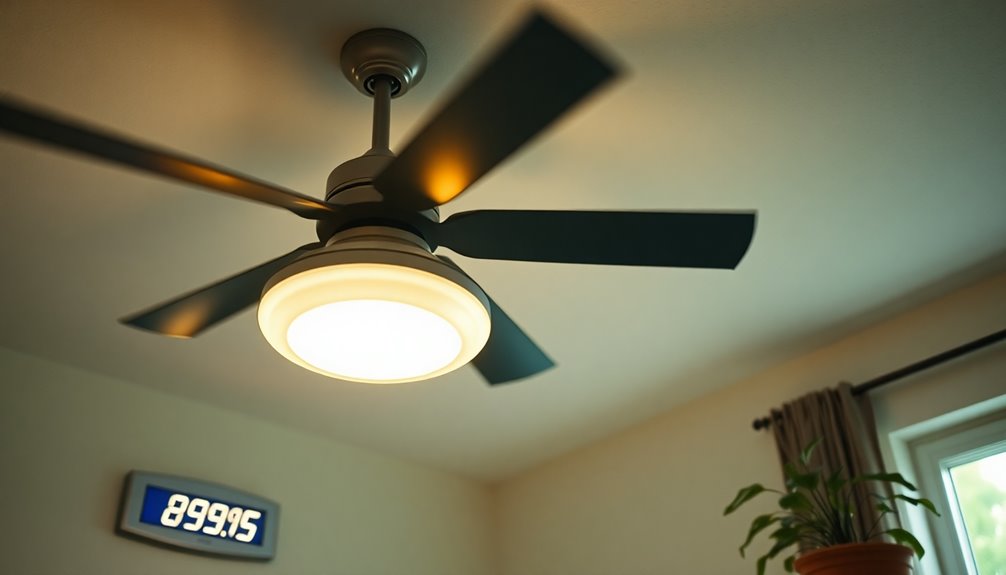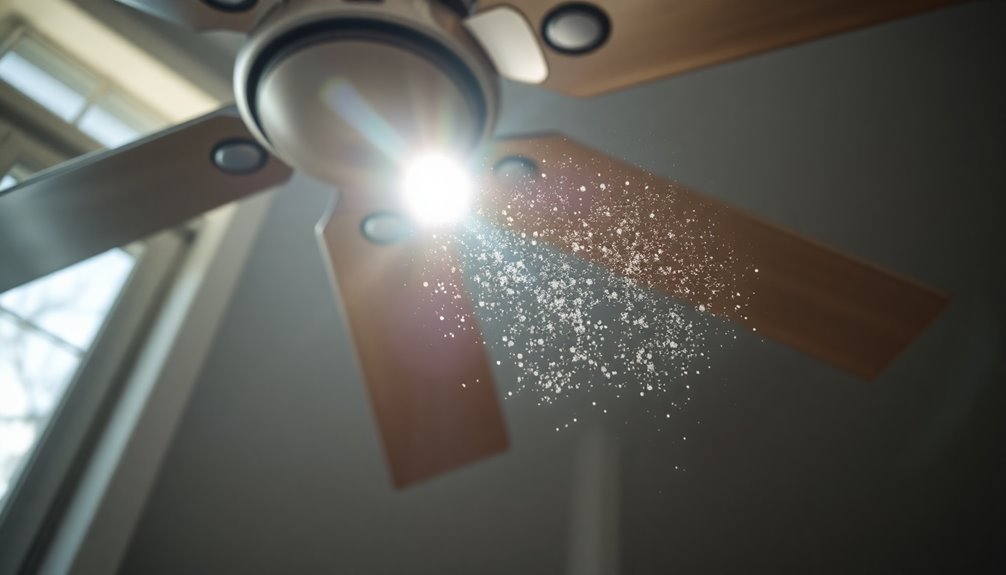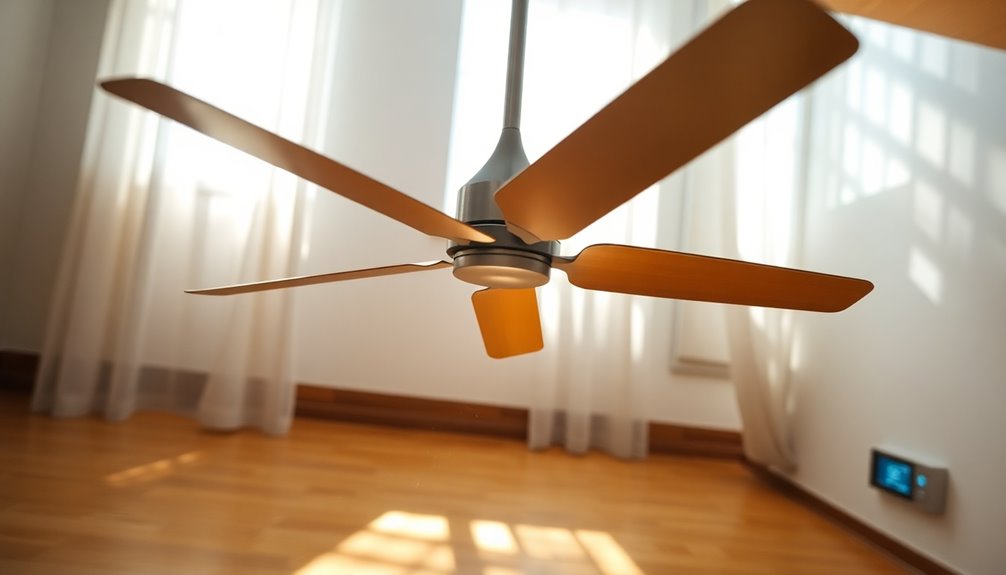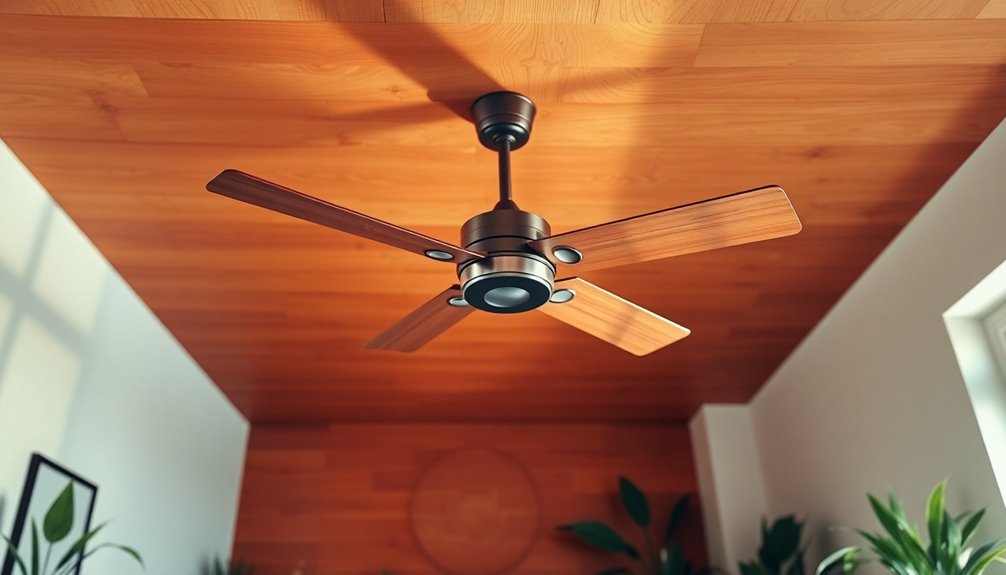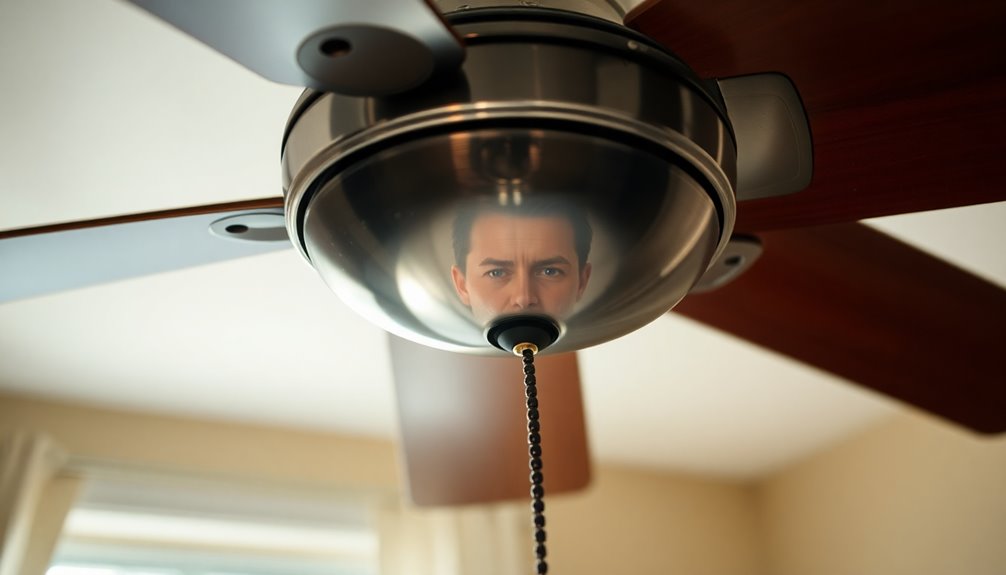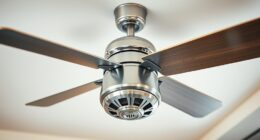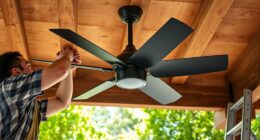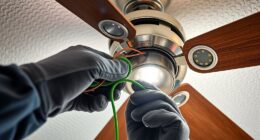Running a ceiling fan 24/7 usually costs you between $0.24 and $0.48 per day. This translates to roughly $7.20 a month or up to $175.20 a year, depending on the fan's wattage. Most standard ceiling fans consume around 75 watts, making them much cheaper to run than air conditioning, which can set you back $3.36 to $8.40 daily. If you're mindful about the fan's usage, like operating it in occupied rooms or cleaning it regularly, you can further cut costs. There's plenty more to explore on maximizing your cooling efficiency and keeping costs low.
Key Takeaways
- The average cost to run a ceiling fan continuously is approximately $0.24 to $0.48 per day.
- Monthly costs for constant use typically range from $6.00 to $15.00, averaging around $7.20.
- A standard 75-watt ceiling fan consumes about 1.8 kWh daily when running 24/7.
- Annual operating costs vary from $87.60 to $175.20, depending on the fan's wattage.
- Using energy-efficient models, like ENERGY STAR fans, can significantly reduce operating costs by up to 60%.
Understanding Ceiling Fan Costs

When you consider running a ceiling fan, it's essential to understand the costs involved. The average cost to run a ceiling fan continuously for 24 hours ranges from $0.24 to $0.48, depending on the fan's wattage and your local electricity rate. A standard 48-inch ceiling fan typically consumes about 75 watts per hour, leading to an average monthly operation cost of around $6.00 to $15.00 if you use it constantly.
Keep in mind that the costs can vary greatly based on energy efficiency. ENERGY STAR-certified fans can save you up to 60% on energy costs compared to standard models, making them a smart choice if you want to keep expenses down.
To calculate the exact cost, you'll need to determine the fan's wattage, convert it to kilowatts, and multiply by the cost per kilowatt-hour, which is usually around $0.13 in the U.S.
Lastly, remember that regularly turning off the ceiling fan when you're not using it can lead to additional savings. Fans don't lower room temperature; they create a breeze effect for comfort, so use them wisely!
Calculating Daily and Monthly Expenses
To calculate how much it costs to run your ceiling fan, you'll want to look at daily, monthly, and even annual expenses.
By estimating daily costs based on wattage and electricity rates, you can break down your monthly expenses effectively.
Understanding these figures helps you budget and compare cooling options wisely.
Estimating Daily Costs
Estimating the daily costs of running a ceiling fan can help you manage your energy budget effectively. A standard 48-inch ceiling fan typically uses about 75 watts.
If you keep that ceiling fan running continuously for 24 hours, it'll cost you approximately $0.24 to $0.48 per day. To get a clearer picture, you can calculate the cost to run your fan by multiplying its wattage by the hours you use it, then dividing by 1,000 to convert to kilowatts.
So, for a 75-watt fan, you're looking at 1.8 kWh of energy consumed each day (75 watts x 24 hours ÷ 1,000). At an average electricity cost of about $0.13 per kilowatt-hour, you're spending around $0.234 daily just on that fan.
Understanding these figures helps you make informed decisions about your cooling strategies while keeping an eye on your overall electricity cost.
Monthly Expense Breakdown
Over the course of a month, the expenses associated with running a ceiling fan can add up considerably, especially if it's in constant use.
If you operate a standard 48-inch ceiling fan 24/7, you'll see daily energy usage of about 1.8 kWh, which translates to a daily cost of around $0.24 based on an average electricity rate of $0.13 per kWh. Multiply that by 30 days, and you're looking at a monthly expense of about $7.20.
While this figure is based on typical usage, it can vary depending on the fan's wattage. For instance, a fan using 75 watts might incur costs ranging from $7.20 to $14.40, influenced by how often you run it.
To accurately calculate your monthly expenses, just take the daily kWh usage, multiply it by the number of days in the month, and then by the cost per kWh.
Annual Cost Considerations
When you consider the annual costs of running a ceiling fan, the numbers can be quite revealing. Understanding how to calculate the cost can help you manage your budget effectively. A ceiling fan can cost between $87.60 and $175.20 annually, depending on energy consumption and local rates.
Here's a quick breakdown:
| Fan Wattage | Daily Cost ($) | Annual Cost ($) |
|---|---|---|
| 50 | 0.17 | 61.21 |
| 75 | 0.24 | 87.60 |
| 100 | 0.32 | 116.88 |
| 150 | 0.48 | 175.20 |
| 200 | 0.64 | 232.32 |
To calculate the cost of running your ceiling fan, multiply its wattage (in kilowatts) by the hours used per day and then by the cost per kilowatt-hour. For example, a 75-watt fan running continuously costs about $65.70 per year. By comparing these costs to air conditioning, you'll see significant savings while keeping your space comfortable.
Factors Influencing Fan Operating Costs

When you consider the operating costs of your ceiling fan, several key factors come into play.
The size of the fan, its energy efficiency rating, and how long you run it each day can all greatly impact your monthly expenses.
Understanding these elements will help you make smarter choices about your fan usage.
Fan Size Impact
The size of a ceiling fan plays an essential role in determining its operating costs, as larger fans typically consume more wattage compared to their smaller counterparts.
For instance, a 52-inch fan might use around 90 watts per hour, while a 36-inch fan consumes about 55 watts per hour. This difference in wattage translates to varying operational costs, with larger fans costing you between $0.014 per hour and smaller fans around $0.009 per hour.
When you run them 24/7, this results in monthly expenses ranging from $2.11 for a small fan to $3.46 for a larger one.
While larger fans can move air more efficiently, their increased energy consumption can lead to higher bills if not matched properly to your space.
If you're looking to keep costs down, consider energy-efficient fans, especially those labeled with ENERGY STAR, which can save up to 60% on energy consumption compared to standard models.
Ultimately, the right fan size, coupled with energy-efficient features, can make a significant difference in your ceiling fan's operating costs.
Energy Efficiency Ratings
Energy efficiency ratings can considerably influence your ceiling fan's operating costs, helping you save money while staying comfortable. Fans with high energy efficiency ratings, such as ENERGY STAR certification, can save you up to 60% more energy than standard models. This significant reduction in energy consumption leads to lower operating costs, making it a smart choice. Additionally, the use of energy-efficient technologies can further enhance savings on your electricity bill. By utilizing structured data in product descriptions, manufacturers can better communicate their energy efficiency claims to consumers. Understanding the importance of regular maintenance for appliances can also play a role in optimizing their energy use. Installing an air purifier with HEPA filters can also help improve indoor air quality, making your living space more comfortable.
Wattage is another vital factor in determining your fan's operating costs. For instance, a standard 48-inch ceiling fan uses approximately 75 watts per hour. If you run a less efficient fan, your energy bill could increase substantially.
Generally, the cost to run a ceiling fan ranges from $0.01 to $0.02 per hour, translating to about $7 to $15 for continuous use over a month.
Larger fans tend to consume more energy, so choosing the right size is essential for energy efficiency. Additionally, running your fan at lower speed settings can conserve energy, as higher speeds increase wattage consumption. Incorporating smart bathroom technologies into your home can also enhance overall energy efficiency, further reducing operating costs.
Usage Duration Considerations
Usage duration plays an essential role in determining the overall operating costs of your ceiling fan. When you run your fan continuously, especially during warmer months, the cost of running can add up quickly.
A ceiling fan typically uses around 75 watts per hour, translating to a monthly operating cost of approximately $7.20 to $14.40, depending on local energy costs and usage duration.
Consider these factors when evaluating your fan's operating costs:
- Longer usage duration increases energy costs.
- Frequent use can lead to unexpected spikes in your electricity bill.
- Regular maintenance guarantees peak performance and efficiency.
- Choosing the right fan wattage can save you money in the long run.
Comparing Ceiling Fans to Air Conditioning

When it comes to cooling your home, ceiling fans offer a more budget-friendly alternative to air conditioning. Running a ceiling fan continuously for 24 hours typically costs between $0.24 to $0.48, while air conditioning can set you back about $3.36 to $8.40 daily.
This stark difference in fan costs highlights the substantial savings you can enjoy with fans. In terms of energy efficiency, ceiling fans use around 75 watts per hour, compared to central air conditioning systems that draw between 2,000 to 4,000 watts. Additionally, using ceiling fans in conjunction with an air purifier can further improve indoor air quality, creating a more comfortable environment.
This means you can keep your space comfortable without the high energy bills associated with air conditioning. Although fans don't lower room temperature, they create a wind-chill effect that makes you feel cooler, allowing you to set your thermostat higher. Additionally, using ceiling fans can lead to lower energy bills due to their increased fan efficiency, promoting a more pleasant living environment.
Tips for Cost Reduction

To keep your ceiling fan costs in check, only run it in occupied rooms; this simple change can greatly reduce energy waste. By being mindful of when you use your fan, you can considerably lower your running costs.
Here are some additional tips to help you save money:
- Use timers or smart controls to automatically turn off fans after a set period.
- Clean fan blades regularly to improve efficiency and lower energy consumption.
- Adjust the speed to the lowest comfortable setting; higher speeds consume more energy.
- Pair ceiling fans with higher thermostat settings on your air conditioning for greater energy savings.
Implementing these strategies not only helps you manage your ceiling fan costs but also contributes to a more energy-efficient home. Additionally, consider using energy-saving features that can significantly reduce overall energy consumption.
You can enjoy comfort while being conscious of your budget. Remember, every small change you make can lead to considerable savings over time.
Energy Efficiency of Different Fan Types

Choosing the right type of fan can greatly impact your energy efficiency and costs. Ceiling fans typically consume between 30 to 100 watts, with a standard 48-inch fan using around 75 watts per hour.
If you're looking for better energy efficiency, consider ENERGY STAR-certified ceiling fans, which can save you up to 60% more energy compared to standard models. These energy-efficient models not only help reduce your electricity bill but also provide effective cooling.
Table fans can also be a good option, with wattage ranging from 28.5 watts for small models to about 52.7 watts for medium ones. However, larger table fans may consume around 44.3 watts, which isn't always as efficient as ceiling fans.
Bladeless fans, while pricier upfront, offer increased efficiency with fewer moving parts, translating to lower long-term costs.
Additionally, selecting fans with multiple speed settings allows you to optimize energy consumption. Running a fan on a lower speed can markedly reduce its wattage usage, making it a smart choice for comfort without making a dent in your wallet.
Best Practices for Fan Usage

Optimizing energy efficiency doesn't stop with selecting the right fan; how you use it also plays a significant role.
To maximize the benefits of your ceiling fan, follow these best practices that can lower running costs and improve comfort.
- Only run the fan when rooms are occupied to prevent energy waste.
- Use lower speed settings to maintain comfort while cutting energy consumption.
- Turn off the fan when you leave the room to avoid unnecessary electricity costs.
- Regularly clean the blades and check fan direction to enhance efficiency and prolong lifespan.
Additional Cooling Strategies

Effective cooling strategies extend beyond just using ceiling fans; they involve a thoughtful approach to how you manage your home's temperature.
Combining ceiling fans with air conditioning is an energy-efficient way to cool your space. By setting your thermostat a few degrees higher and relying on fans, you can maintain comfort while reducing energy costs. Additionally, using heat pumps can further enhance your home's cooling efficiency by transferring heat rather than generating it, making them a versatile solution for year-round climate control. Regular checks on your heat pumps for preventive maintenance can ensure they operate efficiently.
Strategically placing fans in the warmest rooms can greatly enhance airflow and cooling effectiveness. You should also consider using fans at their lowest comfortable setting, as this can conserve energy while still providing adequate cooling.
Additionally, seasonal fan reversal allows you to maximize energy savings; switch the blade direction to circulate warm air in winter and cool air in summer. Incorporating best value-for-money home security cameras can also enhance your home's overall comfort and security during the hot months.
Regular maintenance, like cleaning the blades and checking for operational efficiency, is vital for ensuring that your fans perform at their best. Furthermore, maintaining your cooling system through regular heat pump maintenance can significantly improve overall efficiency and longevity, reducing the chances of costly repairs. Scheduling routine inspections can help identify potential issues before they become major problems.
These additional cooling strategies can work together to create a more comfortable environment while keeping your energy bills in check. By being proactive in your approach, you'll not only enjoy a cooler home but also contribute to a more sustainable lifestyle.
Frequently Asked Questions
How Much Does It Cost to Run a Ceiling Fan 24 Hours a Day?
If you run a standard 48-inch ceiling fan for 24 hours a day, you're looking at a daily energy consumption of about 1.8 kWh.
At an average rate of $0.13 per kWh, it'll cost you roughly $0.24 each day.
Over a month, that adds up to around $7.20.
Compared to air conditioning, using a ceiling fan is a much cheaper option for keeping your space cool and comfortable.
How Much Electricity Unit Does a Ceiling Fan Use in 24 Hours?
Imagine your ceiling fan as a trusty companion, gently stirring the air around you.
In a 24-hour period, it typically consumes about 1.8 kilowatt-hours (kWh) of electricity. That's like a small sip from your power supply!
When you switch it on, it whirls away, using around 75 watts per hour at full speed.
How Much Does It Cost for a Fan to Run All Night?
Running a ceiling fan all night typically costs you around $0.06 for eight hours, based on an average electricity rate.
If you keep it going overnight every night, you're looking at about $5.40 a month.
That's a small price to pay for comfort, especially compared to air conditioning.
Just remember to turn it off when you leave a room to avoid wasting energy and unnecessary costs!
Do Ceiling Fans Run up Your Electric Bill?
You might think ceiling fans are little energy hogs, but they're actually quite gentle on your electric bill.
When you run one, it uses only about $0.01 to $0.02 per hour, which adds up to a modest monthly expense. Instead of cranking up the air conditioning, those blades create a revitalizing breeze, letting you feel cooler without breaking the bank.
Conclusion
Running a ceiling fan 24/7 can cost about as much as a cup of coffee each day, making it an affordable option for cooling your space. By understanding the expenses and energy efficiency of different fan types, you can make informed choices that keep your home comfortable without breaking the bank. Remember to use your fan wisely and consider complementary cooling strategies to maximize savings. With a little effort, you can enjoy a cool breeze and lower energy bills!
